 Looks like we're dead meat. You know what I want my gravestone to say? “Just like always it was my stupid brother's fault.” 
Author Max Brand, née Frederick Faust, was incredibly prolific for a guy who died early. He produced numerous stories and around a hundred fifty novels, including the source material for film and television's Dr. Kildare, and the 1956 western Brothers on the Trail, which you see here with Robert Stanley cover art. Brand was killed in 1944 at age fifty-one while working as a war correspondent in Italy, but he left quite a literary legacy.
 Colonials in South Africa experience a different type of rhythm and blues. 
South Pacific. South America. South of France. We don't care—we love books sets in exotic places wherever they might be. Tell It on the Drums takes readers to South Africa as five men attempt to escape with $250,000 in diamonds from a dusty mining town called Kimberley and reach Pretoria. The story is basically a western escape tale, set in the late 1800s, when places like the Orange Free State and Cape Colony still existed, and the law was something that could be outdistanced on the back of a good horse. Pursuit is inevitable, but paranoia too. And as you'd expect, the real problem is not the law but the fractious partnership between the quintet of fugitives, which includes fearsome U.S. Civil War rebel Adam, craven Boer mercenary Coenraad, and compulsive French thief Dénis.
The 24/7 throbbing of drums is intelligible to tribespeople, and relays news in rhythm about the robbery. The five fugitives are soon known throughout the land, as are their movements and deeds. They have an inkling reports of their heist have travelled by air, but still think they're escaping secretly. It's an illusion. Too bad none of them understand the drums, because they begin urging that the quintet be herded north for some mysterious purpose. Surprisingly, Krepps splits the group up at that point in the story. Coenraad and Dénis trek upcountry to trick tribesmen out of their riches. Adam and one other continue fleeing to Pretoria. The inside man-turned-unwilling accomplice bolts into the veldt but is taken on by a veteran hunter. All the while the drums say: north, send them north, and it's clear that a reckoning looms.
We'll stop there, but we want to note a great set piece—to steal a cinematic term—involving a mass charge by twenty enraged baboons. It's a centerpiece sequence, all teeth, fangs, gunsmoke, and blood, and it's well written. Krepps is a solid writer on all fronts. Tell It on the Drums moves quickly and there are no moments where the narrative falters or feels forced. All the usual warnings about mid-century literature set in Africa apply, but in this case Krepps gives South African tribespeople agency via his device of coded drum talk. Drums speak in most novels of this type, but this time they're in all places at all times, surrounding the white men, and seem to be the entity in control. It adds a nice layer of dread. Overall, an excellent book, with nice cover art by Robert Stanley.
 Cross-country train trip runs into heavy snow and cultural headwinds. 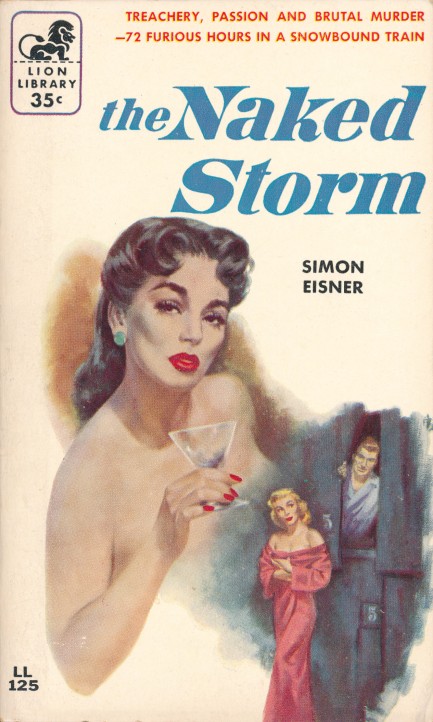
Falling into the category of well-known authors writing lurid fiction under pseudonyms, we have today The Naked Storm by Simon Eisner, from Lion Books in 1956 with a cover by Robert Stanley. Eisner was a cloak for sci-fi author C.M. Kornbluth, who was co-winner of the coveted Hugo Award in 1973 for his short story "The Meeting." The Naked Storm employs as its central plot device a train snowbound on the high Raton Pass during a bitterly cold Colorado winter. Essentially, it's a disaster novel, and you know we always grab those when we can.
This is not the only tale of this ilk Kornbluth was involved with. Perhaps you remember A Town Is Drowning. As is typical of trapped cast novels, a number of ongoing dramas take place here, and these offer windows into mid-1950s sociology. The character unwillingly controlled by organized crime figures, the pretty wife who's a heroin addict, the wide-eyed ingenue, the obese woman carrying a baby that will—shocked, we tell you!—turn out to be brown rather than white, and even the starving wolf that happens upon and begins eating a human body are interesting, but the notable personality here is the predatory lesbian who lacks a single scruple.
For that reason, the novel is an instructive look at the prevalent mid-century belief (which of course never went away in some benighted quarters) that homosexuality is a sickness. While any character can be a villain in fiction, and any character can be a sexual predator, since lesbianism is posited here to be both evil and contagious, the core drama of whether the ingenue will be lured onto track 69 is pure patriarchal hate-mongering. Hilariously, from an authorial point of view, she should choose one of the male characters with whom to bed down. The fact that they're all losers doesn't seem to matter.
So what you get in the end is a textbook example of homophobia in mid-century literature, one that's fit for study, should anyone out there be looking for thesis material. However, it's pretty well written and reasonably engrossing once you slog past the first thirty pages. Also, Kornbluth wrote other books with lgbt themes, such as Half and Sorority House, and because we haven't read them we feel it's only fair to suggest that he may have produced more nuanced, less reactionary work in those (though probably not). Hmm... to read a bigoted novel or not? Serious vintage book fans always face that question. You've been duly informed.
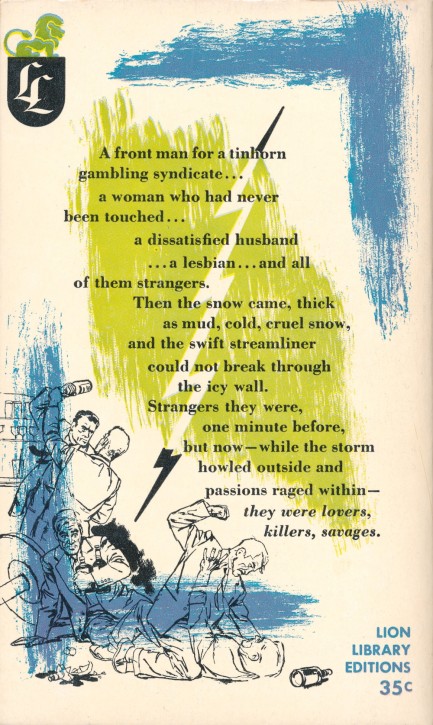
 Some people never even make it to the first day of Christmas. 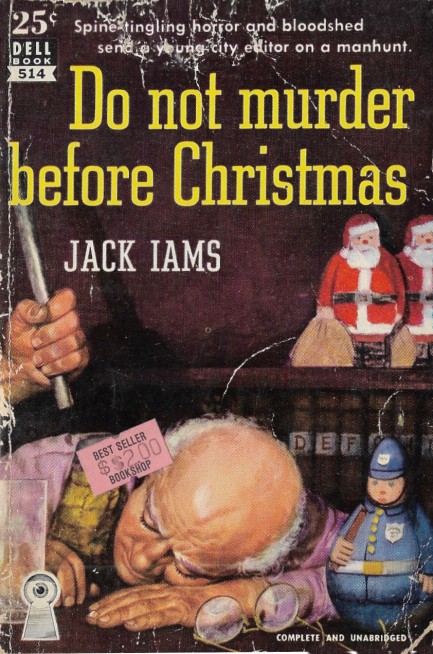
We thought about sharing this cover earlier, but decided to be literal with the title and reveal nothing until after Christmas. Do Not Murder Before Christmas was written by Jack Iams and published in 1949 in hardback by William Morrow & Co., then by Dell as a paperback a bit later the same year. It's a murder mystery in the Agatha Christie vein about an elderly smalltown toymaker whose secret knowledge of his community gets him killed when someone decides to suppress evidence of a crime.
While these sorts of whodunnits aren't hard-boiled or particularly action packed, they're often superior within the crime genre because of their humanized relationships and relatable women. This one is no exception, as a crucial aspect of the puzzle revolves around Jane Hewes, local beauty who's desired by both the scion of a wealthy family that has exploited the town for generations, and by the everyman newspaper editor who has spent years writing unflattering articles about that family. Their rivalry adds plenty to the story. They even have a fistfight.
This is the second Iams mystery we've read, along with Girl Meets Body, and it's clear that he can write as well as construct. The central plot contrivance—that every child who ever came to the toymaker's shop signed a visitor's book, and this somehow has the power to expose a killer—is something so leftfield we had to marvel. The tale's winning protagonist and involving love story make the final result a total winner. If you find an Iams novel anywhere, snag it.
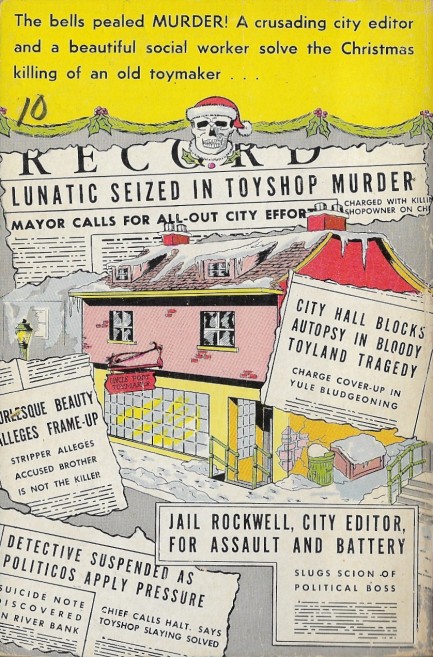
 Okay, I think we're ready. Formula for edible pomegranate flavored body oil, test seventeen, commencing now. 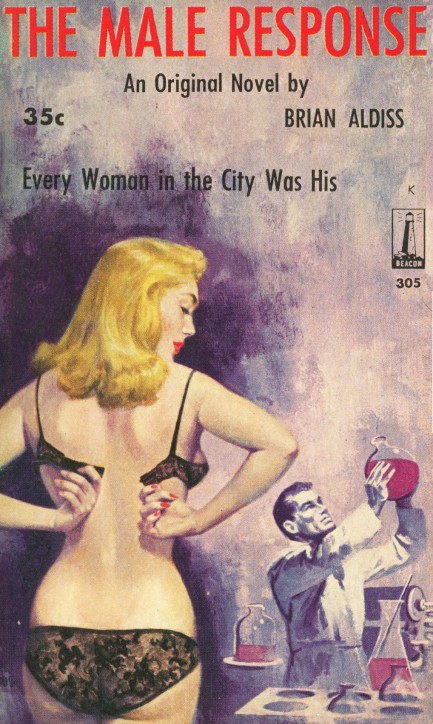
Brian Aldiss was better known as a sci-fi author, but his 1961 novel The Male Response deals with sexual mores and politics. On Aldiss's website he writes: “Only marginally science fiction, the story tells how the indecisive Soames Noyes is sent by his company with a computer to the newly free black state of Goya, in Africa, where he becomes entangled with women and witch-doctors. Reluctantly, Noyes faces all challenges and, following by public promiscuity, becomes President.” That certainly sounds fun, especially the promiscuity to president part. It obviously could only happen in sci-fi. The cover art here is by Robert Stanley.
 Hi, Jane. I hear Tarzan's away for the week. You know, some of us guys living in this jungle have a little class. 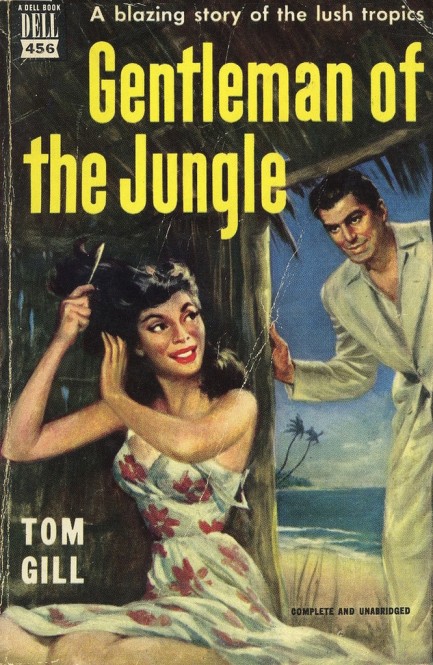
Remember that time Tarzan went all the way to the city to buy bug repellant? Jane was alone, and they'd been having some troubles, and she needed a shoulder to cry on, and Chad, who lives a couple of trees over, happened to be around, and, well, something happened. It lasted like a week. Chad was such an entitled ass it made Jane realize how good she actually had it with the King of the Jungle. And him? What he doesn't know can't hurt him.
 No, it's not a Halloween costume, gringo. We don't have that here. We have Day of the Dead. Wanna find out how it works? 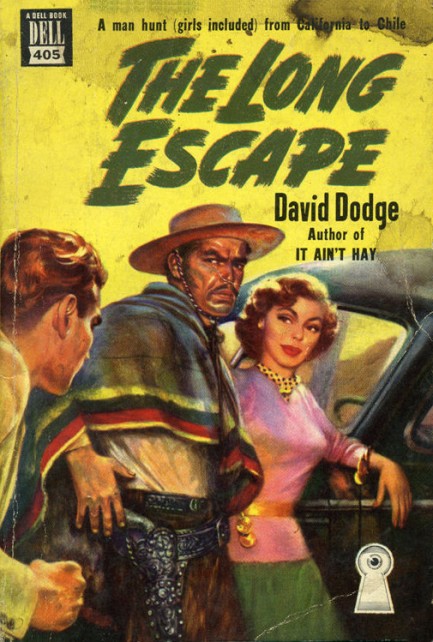
The Long Escape was originally published 1948, and was the first of a trio of books written by David Dodge starring his investigator character Al Colby. The cover art by Robert Stanley depicts a scene that actually occurs in the narrative, but the book is not a western style adventure. It's a missing person mystery that starts in California, passes through Mexico, Guatemala and Honduras, and finally settles in Chile. The man under the poncho is a sort of Chilean vaquero who loves horses and guns, and is a generally hostile guy. But Colby is not one to be easily bested. He may be a gringo, but he's fluent in Spanish, as well as the ways and means of Latin America. The Long Escape is a good book. Everything we've read by Dodge so far is good. In our opinion the second Colby outing, Plunder of the Sun, is even a bit better, but you can't go wrong with this particular author. We'll continue making our way through his catalog and report back.
 Sam Spade chases danger in Dashiell Hammett story collection. 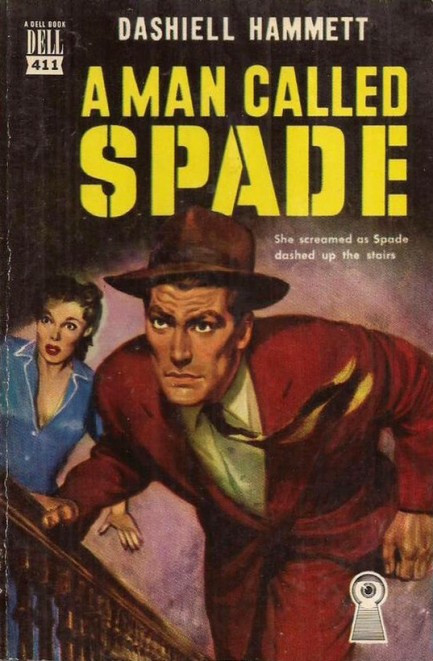
Run don't walk to find any Dashiell Hammett book. He's mandatory reading. In A Man Called Spade you get a tale about a boxer and the fight racket, three stories starring Sam Spade, and, “The Assistant Murderer,” in which Hammett introduces readers to detective Alec Rush, whose physical ugliness is surpassed only by his mental acuity. Hammett really liked the idea of crime solvers who came in unlikely packages. His Continental Op character was short and fat, while Rush had a face only a mother could love. Hammett, a former detective himself, was thin, dapper, and handsome, but he clearly identified with these characters and wanted to de-glamorize detectives. In so doing he became one of most popular authors of detective fiction who ever lived. Besides several nice stories, as a bonus this Dell paperback from 1950 with Robert Stanley cover art is also a mapback edition, as you see below. You have to appreciate how Dell included these maps even when the narrative dictated that they be minimal at best. A Man Called Spade is a good example. All the action in the title story takes place in a single house, and largely in a single room. But Dell gave readers a map anyway. Consistency counts. See alternate art for this book here. 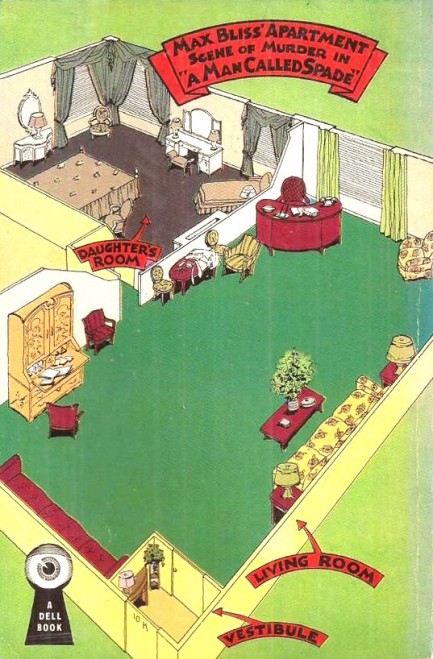
 Tarzan destroyed on social media after posting photo of himself with lion he killed for sport. 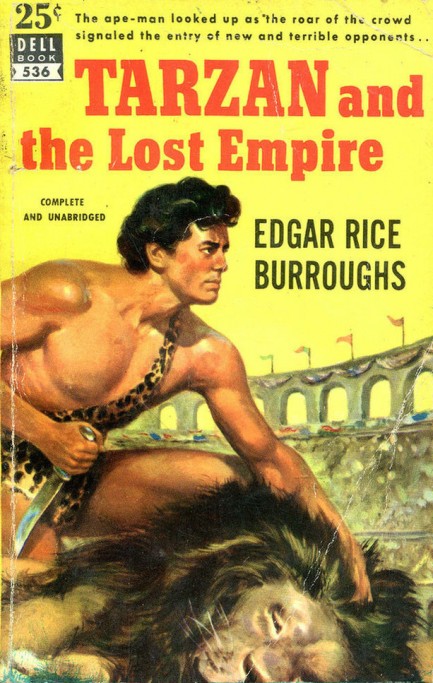
Tarzan and the Lost Empire, originally serialized in 1928 and ’29 in Blue Book Magazine, was entry twelve in Edgar Rice Burroughs' Tarzan series, and some would say the concept had jumped the shark—and the lion—at this point. Basically, Tarzan stumbles upon a remnant of the Roman Empire hidden deep in the mountains somewhere in Africa and—as this 1951 cover by Robert Stanley depicts—is dragged into their coliseum bloodsports. In later books he'd venture to a subterranean world, find a city of talking gorillas, and fly a fighter plane for the RAF (maybe that one isn't so strange, since he had the civilian identity of John Clayton). Burroughs was never mistaken for a great writer, but his Tarzan books sold millions of copies and the character remains one of the best known in pulp literature. As tough as he was, we doubt even the King of the Jungle could have survived social media. But Tarzan was not one with whom to trifle. We can totally picture an adventure where he goes to Silicon Valley to battle the forces of shame. It ends when he learns the evil mastermind is Mark Zuckerberg, swings on a DSL cable into Facebook, and lays waste to the place. “Shame me, Zuckerberg? Me Tarzan! You lame!” 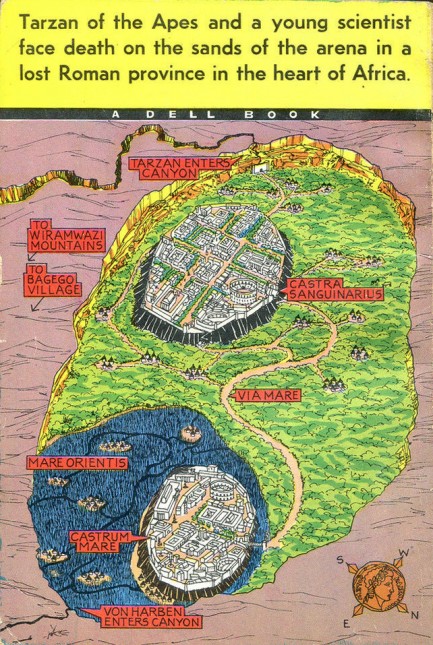
 Ditch the spacesuit, big boy, and I'll give you a totally different kind of terrain to explore. 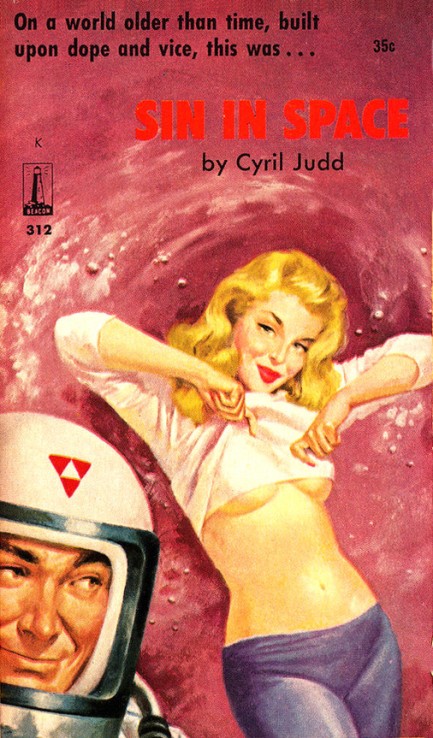
This cover for Cyril Judd's 1961 Mars based sci-fi novel Sin in Space makes the book look like ridiculous sleaze but there's serious ambition here. We discerned this in the first five pages thanks to the undefined jargon, numerous made-up place names, and copious technical language that's supposed to understood through context. The nomenclature of life on Mars, the minerals that are mined, Mars Machine Tool, greeners, marcaine, and much more, are all woven together by Judd (a pseudonym for Cyril Kornbluth and Judith Merril) in an attempt to create a believable alternate reality of a human colony on Mars.
Earth has numerous problems and independence is thought by Mars colonists to mean an escape from those issues. But the colony has a few problems of its own. Most importantly, a stash of drugs has gone missing and if it doesn't reappear the consequences, both political and existential, will be dire. Meanwhile, even though forty years of colonization has turned up no Martian life, sightings of so-called “brownies” are on the upswing, but are dismissed as fantasies. Do these brownies exist? Well, they're more likely to turn up than the rampant sin of the book's title. Check out this passage, which we've edited a bit for brevity:
“You got born into a hate-thy-neighbor, envy-thy-neighbor, murder-thy-neighbor culture. Naked dictatorship and leader worship, oligarchy and dollar-worship. Middle classes with their relatively sane families were growing smaller and being ground out of existence as still more black dirt washed into the ocean and more hungry mouths were born and prices went higher and higher. How long before it blew up? The damned, poverty-ridden, swarming Earth, short of food, short of soil, short of metals, short of everything except vicious resentments and aggressions bred by other shortages.”
Does that sound like sleaze to you? Us either. Sin in Space is a serious book, but far less interesting than it should be, considering the fertile setting. Put it in the wildly misleading bin thanks to its title and the cover by artist Robert Stanley. We mentioned the drugs subplot. That's so far in the background it barely qualifies as a plot driver. The sin of the title actually refers to the fact that a reporter writes an article falsely telling everyone on Earth the Martian colony is a hotbed of vice, thus threatening its status. That's still not a good reason for the sensational title or titillating art, but we don't really mind. A piece of sleazy art—even misplaced—always brightens the day. 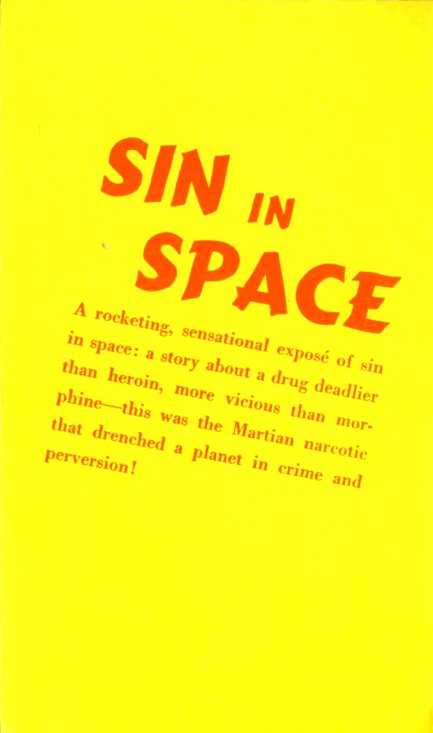

|
 |

The headlines that mattered yesteryear.
2003—Hope Dies
Film legend Bob Hope dies of pneumonia two months after celebrating his 100th birthday. 1945—Churchill Given the Sack
In spite of admiring Winston Churchill as a great wartime leader, Britons elect
Clement Attlee the nation's new prime minister in a sweeping victory for the Labour Party over the Conservatives. 1952—Evita Peron Dies
Eva Duarte de Peron, aka Evita, wife of the president of the Argentine Republic, dies from cancer at age 33. Evita had brought the working classes into a position of political power never witnessed before, but was hated by the nation's powerful military class. She is lain to rest in Milan, Italy in a secret grave under a nun's name, but is eventually returned to Argentina for reburial beside her husband in 1974. 1943—Mussolini Calls It Quits
Italian dictator Benito Mussolini steps down as head of the armed forces and the government. It soon becomes clear that Il Duce did not relinquish power voluntarily, but was forced to resign after former Fascist colleagues turned against him. He is later installed by Germany as leader of the Italian Social Republic in the north of the country, but is killed by partisans in 1945.
|

|
|

It's easy. We have an uploader that makes it a snap. Use it to submit your art, text, header, and subhead. Your post can be funny, serious, or anything in between, as long as it's vintage pulp. You'll get a byline and experience the fleeting pride of free authorship. We'll edit your post for typos, but the rest is up to you. Click here to give us your best shot.

|
|




















![]()
![]()








































































